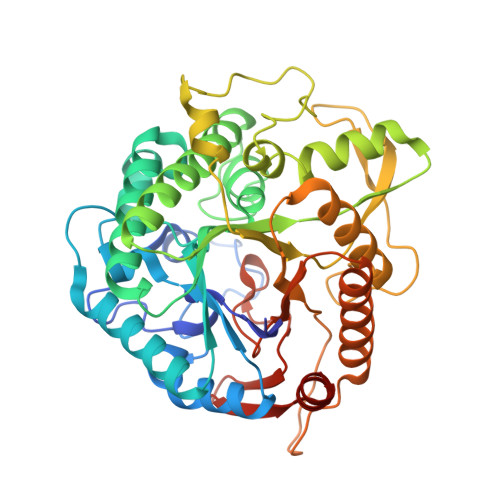Semi-Rational Approach for Converting a Gh1 Beta-Glycosidase Into a Beta-Transglycosidase.
Teze, D., Hendrickx, J., Czjzek, M., Ropartz, D., Sanejouand, Y., Tran, V., Tellier, C., Dion, M.(2014) Protein Eng Des Sel 27: 13
- PubMed: 24287187
- DOI: https://doi.org/10.1093/protein/gzt057
- Primary Citation of Related Structures:
3ZJK, 4BCE - PubMed Abstract:
A large number of retaining glycosidases catalyze both hydrolysis and transglycosylation reactions, but little is known about what determines the balance between these two activities (transglycosylation/hydrolysis ratio). We previously obtained by directed evolution the mutants F401S and N282T of Thermus thermophilus β-glycosidase (Ttβ-gly, glycoside hydrolase family 1 (GH1)), which display a higher transglycosylation/hydrolysis ratio than the wild-type enzyme. In order to find the cause of these activity modifications, and thereby set up a generic method for easily obtaining transglycosidases from glycosidases, we determined their X-ray structure. No major structural changes could be observed which could help to rationalize the mutagenesis of glycosidases into transglycosidases. However, as these mutations are highly conserved in GH1 β-glycosidases and are located around the -1 site, we pursued the isolation of new transglycosidases by targeting highly conserved amino acids located around the active site. Thus, by single-point mutagenesis on Ttβ-gly, we created four new mutants that exhibit improved synthetic activity, producing disaccharides in yields of 68-90% against only 36% when native Ttβ-gly was used. As all of the chosen positions were well conserved among GH1 enzymes, this approach is most probably a general route to convert GH1 glycosidases into transglycosidases.
Organizational Affiliation:
Université de Nantes, CNRS FRE n°3478, UFIP, 2 rue de la Houssinière, F-44322 Nantes cedex 03, France.
















